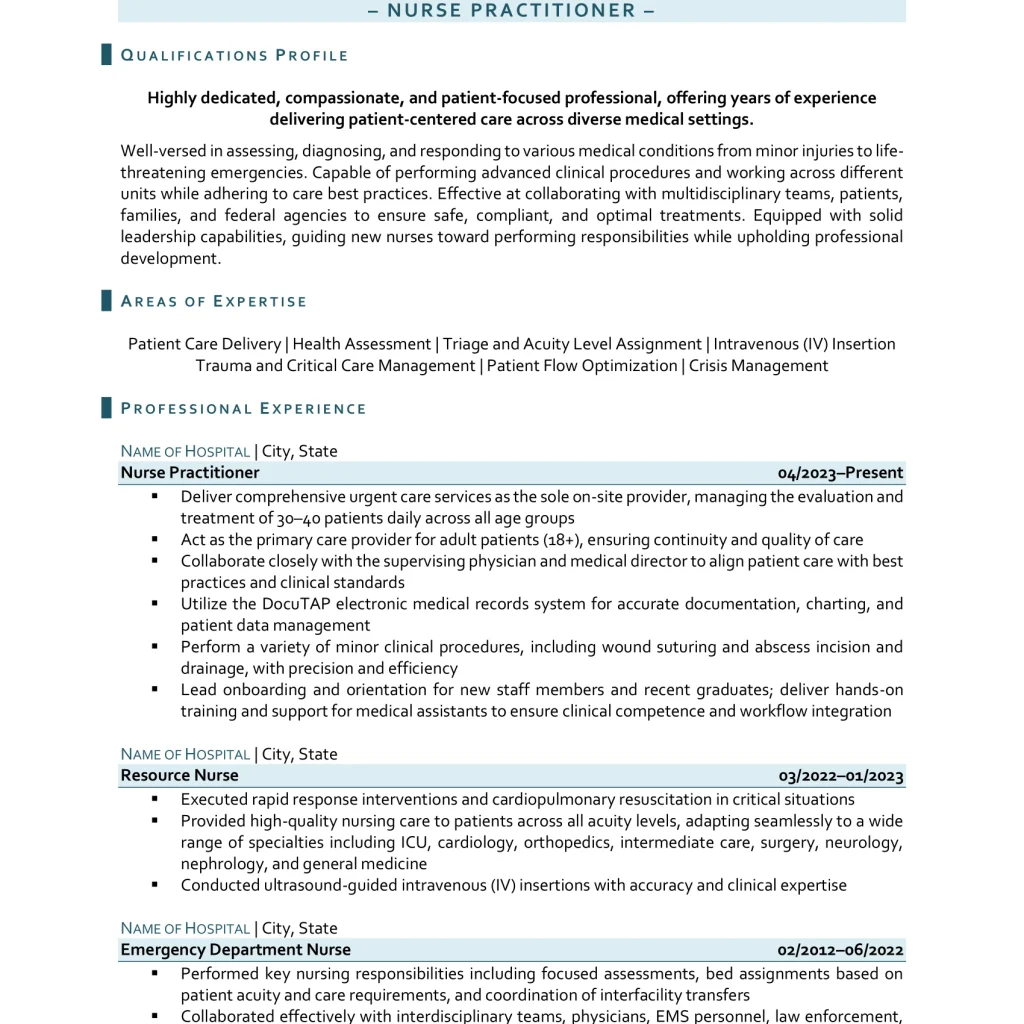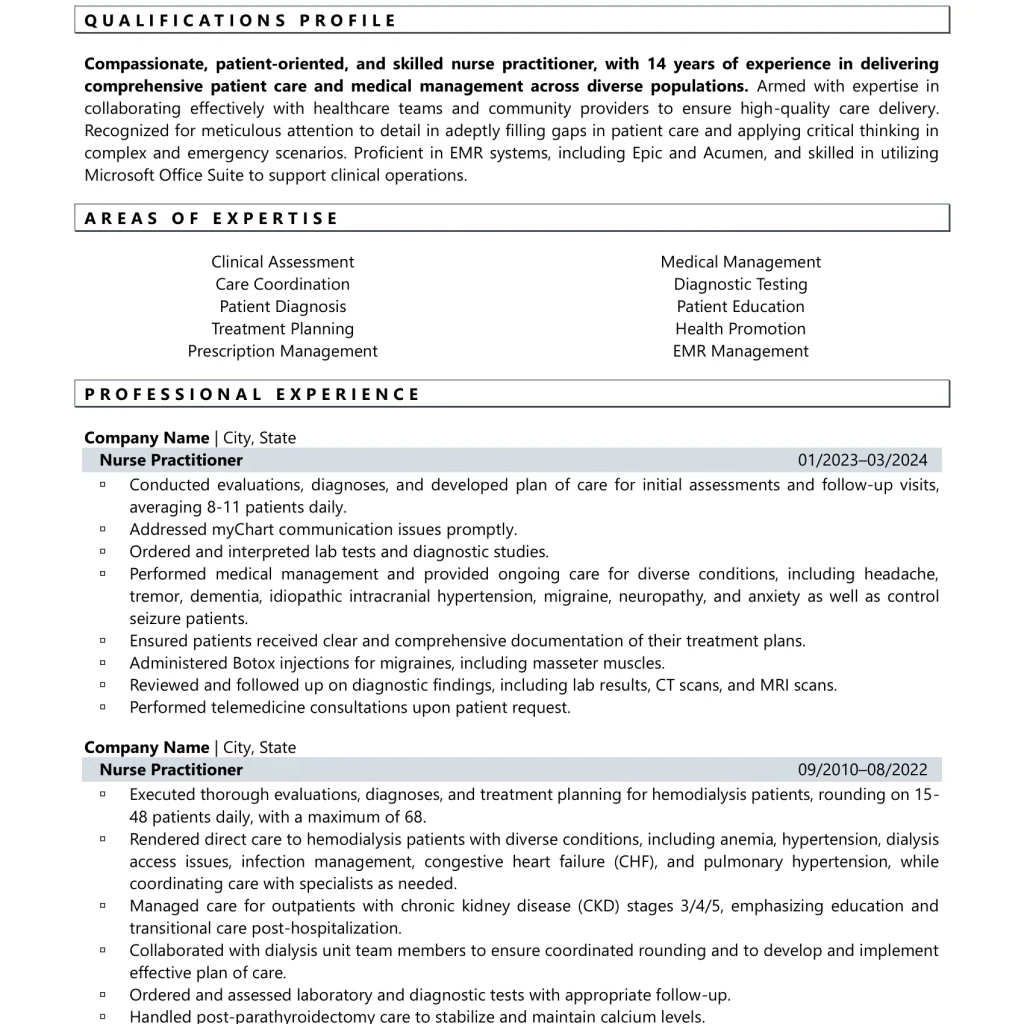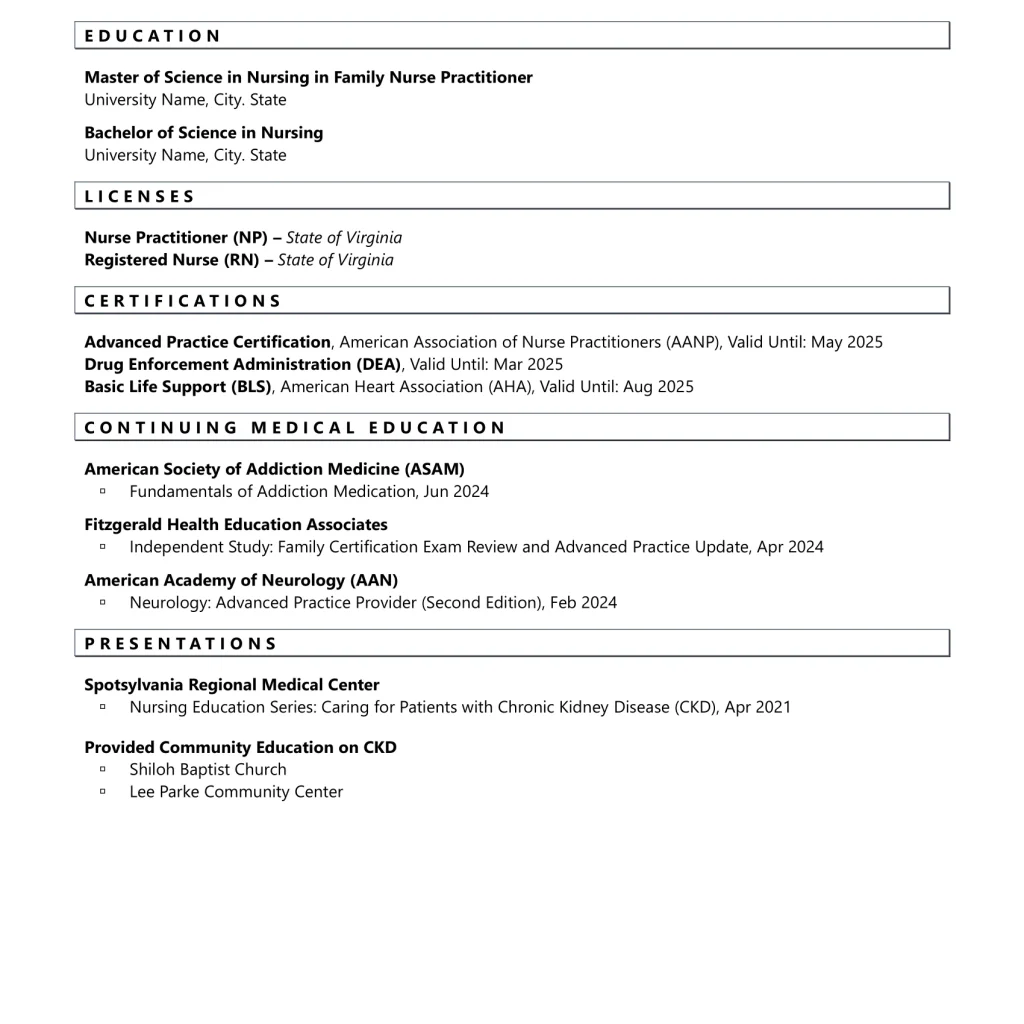Creating a standout resume is important for nurse practitioners who wants to land their ideal job in the healthcare industry. So, having a well-crafted resume can highlight your skills, qualifications, and experience, and set you apart from other candidates. In this guide, we’ll walk you through each step of crafting a resume that highlights your strengths and positions you as a top candidate, along with valuable insights related to the nurse practitioner profession.
When it comes to your resume, showcasing your unique qualifications and experiences in a way that stands out to potential employers will leave a good impression on hiring managers. Before that, we’ll give you an overview of the job position, show you how to present your qualifications effectively, and provide resume examples.
Nurse Practitioner Resume Examples
Explore expertly crafted nurse practitioner resume examples that showcase area of expertise, clinical skills, certifications, and patient care experience tailored for today’s healthcare roles. Use these samples to guide your own resume and stand out to hiring managers in competitive medical settings.
Nurse Practitioner


Download the free Nurse Practitioner Resume Example.
Senior Nurse Practitioner


Download the free Senior Nurse Practitioner Resume Example.
What is a Nurse Practitioner Resume?
A nurse practitioner resume is a job application document that highlights the candidate’s qualifications, skills, and experiences. To craft an effective nurse practitioner resume, include specific details about clinical experience, such as areas of patient care, healthcare settings, and specialized procedures. Highlight achievements, including improved patient outcomes, led initiatives, and contributions to healthcare research or policy.
By presenting a comprehensive and well-rounded set of your skills and dedication to the healthcare industry, you can stand out among the rest of potential employers. Therefore, understanding the differences between a nurse practitioner and a doctor can further clarify the unique value each role brings to patient care. So, what are the distinctions between a nurse practitioner and a doctor?

Nurse Practitioner vs. Doctor: What’s the Difference?
Both nurse practitioners and doctors are dedicated to providing high-quality health care that enhances patient outcomes. They share several responsibilities, such as recording patients’ medical histories, diagnosing health issues, and collaborating to deliver comprehensive patient care.
However, there is a crucial distinction between nurse practitioners and physicians. Nurse practitioners primarily focus on providing patient primary care, which includes wellness guidance on healthy eating, exercise, and smoking cessation programs. On the other hand, physicians are responsible for more complex patient diagnoses, specialty care, and treatments.
The versatile role of nurse practitioners often requires them to take on various responsibilities. They may conduct research on health care-related issues, assume administrative or educational duties, and train staff on new patient care procedures or regulatory policies. This broad scope of practice allows NPs to be valuable resources in multiple aspects of health care delivery.
Physician Assistant vs. Nurse Practitioner: What’s the Difference?
Physician assistants and nurse practitioners undergo distinct training models that shape their approaches to patient care. Physician assistants are trained using the medical model, akin to physicians, which focuses on testing, diagnosis, and treatment of diseases. This training prepares PAs to concentrate on the specific medical conditions affecting patients.
Conversely, nurse practitioners are trained under the nursing model, which emphasizes a holistic approach. This means they focus on the overall well-being of the patient, considering the disease in the context of the patient’s lifestyle, environment, and personal health goals. This patient-centered approach allows nurse practitioners to provide comprehensive care that addresses not only the medical condition but also the broader aspects of the patient’s health.
By understanding these differences, patients can make more informed choices about their health care providers, ensuring they receive the type of care that best suits their needs.
Key Sections of a Nurse Practitioner Resume
Creating a compelling resume is crucial for any nurse practitioner looking to stand out in a competitive job market. Each section of your resume should highlight your unique skills, experience, and qualifications to demonstrate why you are the best candidate for the role.
Here are the key sections every nurse practitioner resume should include:
1. Contact Information
Begin with your full name, phone number, email address, and a professional LinkedIn profile or personal website if applicable. Make sure this information is up-to-date and easy to find at the top of your resume.
Ensure your contact information is easy to find and up-to-date. This section should include:
- Full Name
- Professional Title (e.g., Nurse Practitioner)
- Phone Number
- Email Address
- LinkedIn Profile (optional)
- Address (optional)
2. Professional Summary
Your professional summary should provide a brief overview of your qualifications and career achievements. This is your chance to make a strong first impression. Craft a concise professional summary that captures your expertise, years of experience, and key accomplishments. This section should provide a snapshot of your career and set the tone for the rest of your resume.
Example:
“Compassionate and dedicated Nurse Practitioner with over 10 years of experience in providing high-quality patient care. Proven ability to diagnose and treat a wide range of medical conditions, with a focus on holistic patient care. Skilled in patient education, chronic disease management, and emergency response.”
Tips for Writing a Professional Summary:
- Keep it short and to the point (3-5 sentences).
- Highlight your years of experience and key skills.
- Mention any specialized areas of expertise.
- Use keywords relevant to the job description.
3. Skills
Highlight key skills that are relevant to the nurse practitioner role. This can include both technical skills and soft skills. Include a section dedicated to your core competencies and technical skills. This might encompass clinical skills, patient care techniques, diagnostic abilities, and proficiency with medical software or equipment. Tailor this section to align with the specific requirements of the job you are applying for.
Example:
- Patient Assessment and Diagnosis
- Chronic Disease Management
- Patient Education
- Prescriptive Authority
- Emergency Response
- EHR Proficiency
- Strong Communication Skills
- Leadership and Team Collaboration

4. Clinical Experience
Ready to make your work experience truly shine? It’s not just about listing your past jobs—it’s about showcasing your unique contributions and achievements. Many resumes focus on day-to-day tasks, but hiring managers already know these details—they’re the ones who write the job descriptions. To impress, you need to go beyond basic responsibilities.
Detail your clinical experience, starting with the most recent positions. Include the name of the employer, location, dates of employment, and your role. Highlight your responsibilities, patient population served, and any notable achievements or contributions in each role.
When detailing your professional experience, focus on achievements and responsibilities that demonstrate your competency and value as a nurse practitioner. Use bullet points and start each with a strong action verbs to make your experience stand out.
Examples of Action Verbs
- Administered
- Diagnosed
- Managed
- Prescribed
- Coordinated
- Educated
- Implemented
- Supervised
How to List Clinical Experience
Nurse Practitioner, ABC Medical Center
January 2015 – Present
- Conduct comprehensive patient assessments and develop treatment plans.
- Manage chronic diseases such as diabetes and hypertension.
- Prescribe medications and therapies in accordance with state regulations.
- Educate patients on disease prevention and health management.
- Collaborate with physicians and healthcare teams to ensure continuity of care.
- Supervised and mentored nursing staff, improving team efficiency and patient outcomes.
Related Article: Resume Bullet Points: How to Use Them Effectively for Your Medical Resume
5. Education
List your educational background, including degrees, certifications, and relevant coursework. Include the names of the institutions, graduation dates, and any honors or distinctions received. Don’t forget to mention your nurse practitioner certification and any state-specific licenses.
List your educational background, including degrees, certifications, and relevant coursework.
Example:
Master of Science in Nursing (MSN)
XYZ University, 2014
Bachelor of Science in Nursing (BSN)
XYZ University, 2010
6. Certifications
Certification is vital for nurse practitioners as it demonstrates their expertise, commitment to quality care, and adherence to high professional standards. It validates their knowledge and skills, assuring employers and patients of their competence. Certifications, such as those from the American Nurses Credentialing Center (ANCC) or the American Association of Nurse Practitioners (AANP), enhance a nurse practitioner’s credibility and marketability, often being required or highly preferred by employers. This credential can also lead to advanced practice roles, higher salaries, and leadership positions by showcasing specialized training and a commitment to evidence-based practice.
Additionally, certifications play a critical role in maintaining high standards in healthcare by promoting ongoing education and adherence to best practices. Periodic renewal of certifications ensures that nurse practitioners stay updated with the latest advancements in medical knowledge, technology, and treatment protocols, which is essential in a rapidly evolving healthcare landscape. Therefore, certifications are not only markers of past achievements but also a commitment to future excellence and lifelong learning, significantly impacting patient outcomes and the overall quality of care.
Example:
- Certified Nurse Practitioner (CNP)
- Advanced Cardiovascular Life Support (ACLS) Certification
- Basic Life Support (BLS) Certification
7. Additional Sections
Professional Affiliations and Continuing Education
Showcase your commitment to professional growth by listing memberships in relevant professional organizations, such as the American Association of Nurse Practitioners (AANP) or other state-specific groups. Additionally, mention any continuing education courses, workshops, or conferences you have attended to stay current in the field.
Professional Memberships
- Member, American Association of Nurse Practitioners (AANP)
- Member, National League for Nursing (NLN)
Volunteer Work
- Volunteer Nurse, Community Health Clinic, 2018 – Present
Additional Tips for Nurse Practitioner Resumes
Tailoring your resume for each job application is crucial. Highlight the most relevant experience and skills that match the job description. Use action verbs to start each bullet point, conveying your responsibilities and achievements clearly. Keeping the format clean and professional is essential for readability. Proofread thoroughly to avoid spelling and grammatical errors.
A common question about nurse practitioner resumes is about the ideal length. Generally, aim for a one to two-page resume, ensuring it is concise yet comprehensive. Focus on the most relevant information and avoid including irrelevant details.
In addition to a strong resume, crafting a effective cover letter is essential for making a lasting impression. Your cover letter allows you to elaborate on your skills and experiences, providing context that can set you apart from other candidates.
To make your resume stand out, use a clean and professional format. Highlight your most relevant skills and experiences, and customize your resume for each job application. These steps will help ensure your resume is noticed and remembered by potential employers.
Enhance Your Job Search with ResuMeds’ Expert Physician CV Writers
In today’s competitive job market, a well-crafted nurse practitioner resume is crucial for standing out. Whether you are applying for residency programs, academic positions, medical roles, or memberships in professional medical organizations, a polished resume is essential to advance your application to the next stage.
Our team of seasoned medical resume writers and career experts deeply understand the healthcare industry. We can assist you in producing a nurse practitioner resume that highlights your clinical expertise, leadership skills, and compassionate care. At ResuMeds, we are dedicated to helping you succeed in your job search. Contact us today to take the first step toward a brighter professional future.






